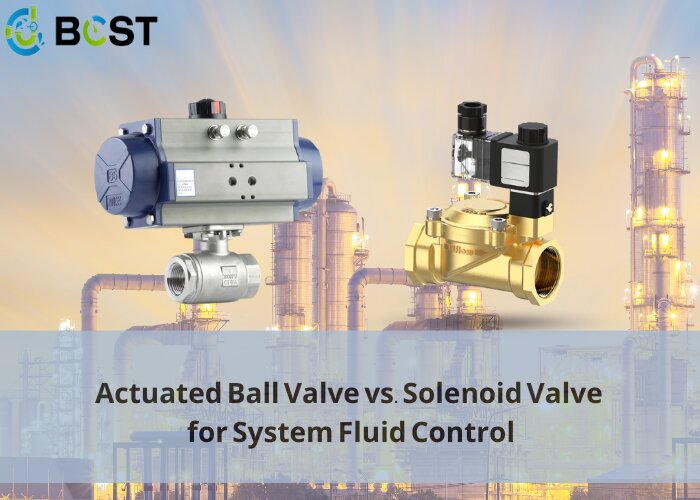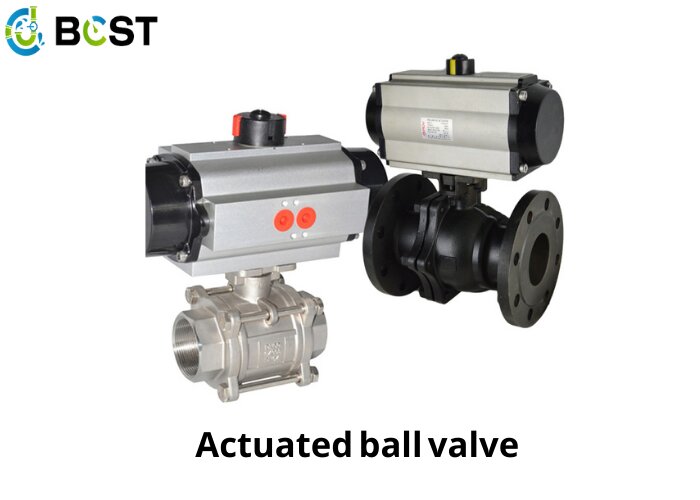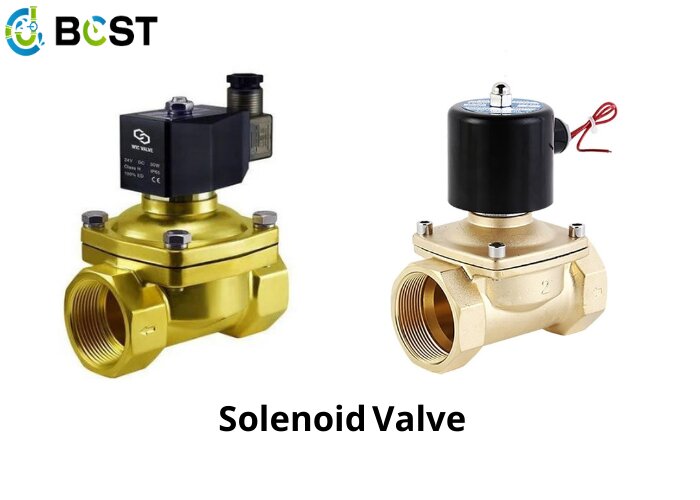
Welcome to our exploration of the critical decision-making process between two powerhouses in fluid control systems: the actuated ball valve and the solenoid valve. When it comes to efficiently managing fluid flow within a system, choosing these two technologies carries significant implications for performance, reliability, and overall effectiveness. In this blog, we’ll delve into the key factors differentiating actuated ball valves and solenoid valves, guiding you through considerations such as pressure handling, construction materials, speed, cycle life, fail-safe designs, and more. By the end of this journey, you’ll be equipped with the insights needed to make an informed decision tailored to your specific fluid control needs.
Actuated Ball Valve vs. Solenoid Valve
Actuation Arrangement
When considering the operation of a valve, the actuation method plays a crucial role. Unlike a ball valve, which offers various actuation options such as pneumatic or electric actuators and manual operation through a lever or handle, a solenoid valve’s actuation is solely dependent on an electric current. In the case of a solenoid valve, the actuation involves sending an electric current to magnetize a ferromagnetic coil within the valve’s construction, determining whether the device remains open or closed. This fundamental difference highlights the diverse choices available for driving a ball valve compared to a solenoid valve’s more electrically constrained nature.
Power Choices
While a ball valve can incorporate an electric actuator with commonly available power supplies like 120 VAC or 24 VDC, a solenoid valve usually offers a broader range of AC or DC options for actuation. The distinctive feature of non-intrinsic actuation in ball valve assemblies also grants them the advantage of providing more manual override options. The inclusion of a manual override allows users to operate the valve manually, overriding the actuator, typically facilitated by a handwheel or a similar mechanism. This flexibility in actuation methods makes ball valves adaptable to various operational needs and preferences.
Size
The required valve size significantly influences the choice between a ball valve and a solenoid valve. Solenoids, being more space-efficient, are advantageous in terms of installation space. However, this advantage diminishes as the required valve size increases significantly beyond 2 inches. Smaller solenoid valves can operate directly, but larger sizes often adopt a pilot-operated configuration, relying on a pilot valve influenced by the solenoid’s action. This configuration introduces a sizing limitation and requires a pressure differential.
In contrast, ball valves, irrespective of size, do not face such limitations or reliance on pilot-assisted operation. They can accommodate larger sizes, allowing for higher flows compared to solenoids. Even in comparable line sizes, the Cv factors for ball valves will likely surpass those of solenoids, making them a more versatile choice for various flow requirements.

Operating Pressure
The application’s pressure requirements also influence the choice between the solenoid and ball valves. While both options come in various designs to suit different working pressures, a high-pressure ball valve can handle significantly higher pressures, ranging from hundreds to tens of thousands of psi. In contrast, a solenoid valve is generally limited to accommodating pressures in the hundreds of psi. This limitation affects both the maximum inlet and back pressure on the discharge side that the valve can handle effectively. A high-pressure ball valve is a more suitable choice in applications with elevated operating pressures or intermittent pressure spikes, given its capacity to handle higher pressure ranges.
Speed and Cycle Life
The application’s operational speed and cycle life requirements influence the selection between a solenoid valve and a ball valve. Solenoid valves typically boast faster response times, allowing them to cycle more quickly than ball valves within the same time frame. Electrically actuated ball valves, especially, may exhibit slower stroke speeds, measured in seconds rather than the milliseconds often seen in solenoids. Additionally, electric actuators in ball valves may have limited duty cycles, necessitating specific non-operating intervals to prevent motor overheating. Beyond speed, solenoid valves generally offer a significantly higher cycle life, meaning they can undergo many opening/closing cycles under ideal conditions before requiring maintenance or replacement, surpassing the cycle life of ball valves by orders of magnitude.
Materials of Construction
Manufacturers predominantly provide solenoids in stainless steel and brass, but the construction options for ball valves are notably more diverse. In addition to the common materials like bronze, carbon steel, and stainless steel, ball valves are available in plastics such as PVC, PVDF, and Polypropylene, as well as exotic alloys like Hastelloy and Alloy 20. This extensive range of construction materials allows ball valves to cater to a wider spectrum of chemical compatibility requirements than liquid or gas solenoid valves. While both types can perform well in clean gas and liquid applications, the design and material diversity of ball valves make them more effective in resisting contaminants and particulates in the media. Moreover, ball valves offer a greater variety of end connection options, including threaded, flanged, tri-clamp for sanitary applications, and socket-weld for situations requiring welding. These factors and the ability to withstand extreme temperatures contribute to making ball valves more versatile in various applications.

Failure Mode
A notable advantage of a 2-way or 3-way solenoid valve lies in its intrinsic fail-safe design, featuring a predetermined fail-position as a standard feature without the additional cost associated with a ball valve assembly. A two-way solenoid valve can be configured to be normally closed or normally open, and when de-energized, it automatically returns to its normal position via a spring. Similarly, a 3-way solenoid valve, despite having different porting options, has only two states: energized and de-energized, returning to its normal state through a spring when de-energized. In contrast, a double-acting pneumatically actuated or electrically actuated ball valve, whether 2-way, 3-way, or multi-ported, will fail in place on the loss of its actuation signal without automatically returning to a designated position. While fail-safe options like spring return pneumatic actuators and fail-safe electric actuators exist for ball valves, they often come with added weight, size, and cost, making solenoid valves a more economical choice for many fail-safe applications.
On-Off versus Modulating Control
When considering the control of a valve’s operation within a process, the distinction between on-off and modulating control becomes crucial. For applications where the valve needs to function in only open or closed states, the solenoid, with its energized and de-energized states, excels in providing responsive and reliable on-off control. However, when the application demands modulation through various stages between open and closed, ball valve assemblies offer greater adaptability. This is achieved through the integration of a modulating card in electrically actuated assemblies or the use of a pneumatic or electro-pneumatic positioner in air-driven assemblies. Additionally, manufacturers can incorporate a v-slot into the ball itself, enabling precise control of media flow as the actuator modulates, making ball valves a preferred choice for modulating service.
Final Thoughts
Finally, let us talk about the relationship between the actuated ball valves and solenoid valves, it is clear that according to the requirement, these two both have unique advantages, choosing two valves based on various elements, such as pressure, structure material, speed lifelong and needs for the fail-safe design. In terms of material selection, various terminations, and resistance to contamination. the electric ball valve varies in many ways, therefore it is suitable for wide applications.On the other hand, solenoid valves excel in responsiveness, and intrinsic fail-safe features, and are often more cost-effective in fail-safe applications. The decision ultimately boils down to the nuances of each system’s demands — whether it’s rapid on-off control, modulation through various stages, or compatibility with specific materials and pressures. By carefully weighing these factors, one can make an informed choice between actuated ball valves and solenoid valves to ensure the most effective fluid control within a given system.






